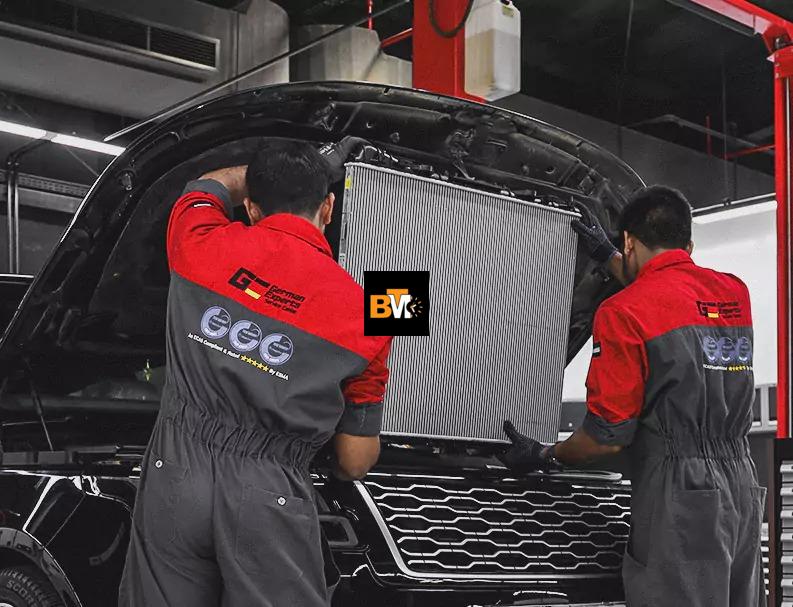You know what really gets under my skin? Walking into my garage every morning and seeing cars damaged by bad advice floating around the internet. After spending 20 years getting my hands dirty with radiator repair Dubai, I’ve got some real stories to share about what works and what’s just plain nonsense. Let me break down these radiator myths that keep showing up in my shop day after day.
The Real Deal with Stop-Leak Products
Man, if I had a dollar for every time someone rolled into my shop after dumping a bottle of stop-leak into their radiator… Just last week, Tom (one of my regular customers) came in with his Ford F-150, proud as punch about how he’d “fixed” his leak with some miracle solution from the auto parts store. Poor guy had no idea he was about to face a much bigger repair bill. Here’s the thing – I’ve seen these products turn coolant into something that looks like chocolate pudding inside the radiator. Sure, it might plug that leak temporarily, but it’s similar to putting a band-aid on a broken arm. The gunk doesn’t just stay where the leak is; it flows through your entire cooling system, clogging up everything from your heater core to your water pump. Trust me, I’ve spent countless hours flushing systems trying to undo this kind of damage.
The Rainbow of Coolant Colors: What’s Really Going On?
Let me tell you about Sarah’s Honda that came in last Thursday. She was absolutely convinced her mechanic had ripped her off because the new coolant was orange instead of green. I had to sit her down and explain something that most folks don’t realize. These colors aren’t like picking out paint for your kitchen – they actually mean something specific to your car’s make and model. I’ve seen perfectly good coolant changed out simply because someone thought the color was “wrong.” It’s like assuming all red wines taste the same just because they’re red. Each manufacturer has their own formula, and mixing them up is about as smart as putting diesel in a gas engine. I’ve spent too many Monday mornings cleaning out systems where someone played mix-and-match with their coolants.
The Great Flush Debate: How Often Is Too Often?
Here’s something that really boils my blood – those quick-lube places pushing radiator flushes every other oil change. Just yesterday, I had Mike bring in his three-year-old Toyota after another shop told him he needed his third flush this year. What a load of nonsense! Modern coolant technology has come a long way since I started turning wrenches in the ’90s. These days, most coolants are designed to last 50,000 miles or more. I’ve seen perfectly good coolant drained just because some computer system said it was time. It’s like throwing away half a tank of gas because someone told you it was “too old.”
What Your Temperature Gauge Isn’t Telling You
This reminds me of Linda’s case last summer – her Chevy’s temperature gauge read normal right up until she ended up stranded on the highway. The gauge showed everything was fine, but underneath, her radiator was hanging on by a thread. I’ve learned over decades that your cooling system can be like an iceberg – the gauge only shows you what’s floating above water. The real problems – the corroded connections, the weakening hoses, the tiny pinhole leaks – are all happening silently until things go south. I can’t count how many times I’ve caught major issues during routine inspections that would’ve turned into roadside disasters.
The Replace-or-Repair Dilemma
Speaking of expensive lessons, let’s talk about premature radiator replacement. Bob came in last month, and quoted $800 for a full radiator replacement at another shop. Turned out, his radiator just needed a simple repair to the upper tank – a $150 fix. Look, I get it – sometimes replacement is necessary. But after fixing thousands of radiators, I can tell you that about 60% of the radiators I see marked for replacement could’ve been saved with proper repairs. It’s like demolishing a house because the gutters are leaking. Sometimes, the fix is simpler (and cheaper) than you think.
The Cold Truth About Radiator Care
Every winter, without fail, I get calls about frozen radiators. People seem to think that cold weather means they don’t need to worry about their cooling system. Let me tell you about Jack’s BMW – he skipped his fall coolant check last year, thinking the cold weather would keep his engine cool enough. Found himself with a cracked block in January when the watered-down coolant froze solid. Your radiator isn’t just about keeping things cool; it’s about maintaining the right temperature all year round. I’ve seen too many preventable freeze-ups turn into engine rebuilds.
Modern Cars, Modern Problems
Working on today’s vehicles is like being part mechanic, part computer technician. These new cooling systems are complex beasts – sensors everywhere, multiple cooling circuits, electric water pumps. Just last week, I had a hybrid in the shop that needed specialized equipment just to burp the cooling system. But here’s what hasn’t changed: the basics of good maintenance. Whether it’s a 1970 Chevelle or a 2024 Tesla, neglect will kill a cooling system faster than anything else.
What Your Radiator Really Needs
After spending most of my life under hoods, I can tell you this: your radiator isn’t asking for much. Regular checks, the right coolant, and addressing small problems before they become big ones. Every day in my shop, I see the results of both good Car maintenance and neglect. The choice between a simple fix now or a major repair later is yours to make. But take it from someone who’s been there – prevention is always cheaper than the cure.
This business isn’t just about fixing cars; it’s about helping people avoid unnecessary problems and expenses. Every vehicle that leaves my shop is a testament to doing things right the first time. Remember, your radiator might not be the most exciting part of your car, but it’s definitely one of the most important. Take care of it, and it’ll take care of you.







Leave a Reply